About
What Are Hot Flashes?
Quick Facts about Hot Flashes
- The reason hot flushes are one of the most talked-about symptoms of menopause is that they affect up to 85% of women between 45 and 60 years old.
- Hot flashes affect up to 75% of pregnant women, especially during their second and third trimester.
- Up to 90% of women report getting hot flashes at least once during the weeks following birth.
- While it is much rarer to experience them during PMS, many women who are suffering from PMS's more serious form, premenstrual dysphoric disorder (PMDD), report experiencing hot flashes during the final week before their periods.
Hot flashes are defined as the sudden influx of intense heat that floods the face, head, and neck in a matter of seconds, only to disappear moments later. They are usually accompanied by momentary blushing and sweating and may be followed by cold chills.
While the term hot flash is mostly used to refer to the sudden heating that occurs during the day, when they occur at night they are called night sweats, and they may be so severe as to disrupt sleep or cause a woman to wake up in the middle of the night. In contrast, for other women, night sweats may be unnoticeable in the heat of the moment but later cause them to wake up to drenched bed sheets.
Hot flashes and night sweats are mostly caused by an imbalance in the levels of a woman's sex hormones. They are a very common symptom of perimenopause and postmenopause, but many women also complain of suffering them during pregnancy, their postpartum year, and even as part of their premenstrual syndrome, due to the hormonal imbalance during these times.
Identifying Hot Flashes
It is difficult to accurately categorize the nature of hot flashes between each individual woman, since the degree of discomfort they produce is largely subjective. The frequency in which they appear may be easier to determine, and as a general rule, women who are experiencing more severe forms of hormonal dysregulation will feel hot flashes more often. That said, there are two main types of hot flash, and they differ in their intensity and duration.
Continue reading to learn about the hormonal and non-hormonal causes of both standard and ember hot flashes.
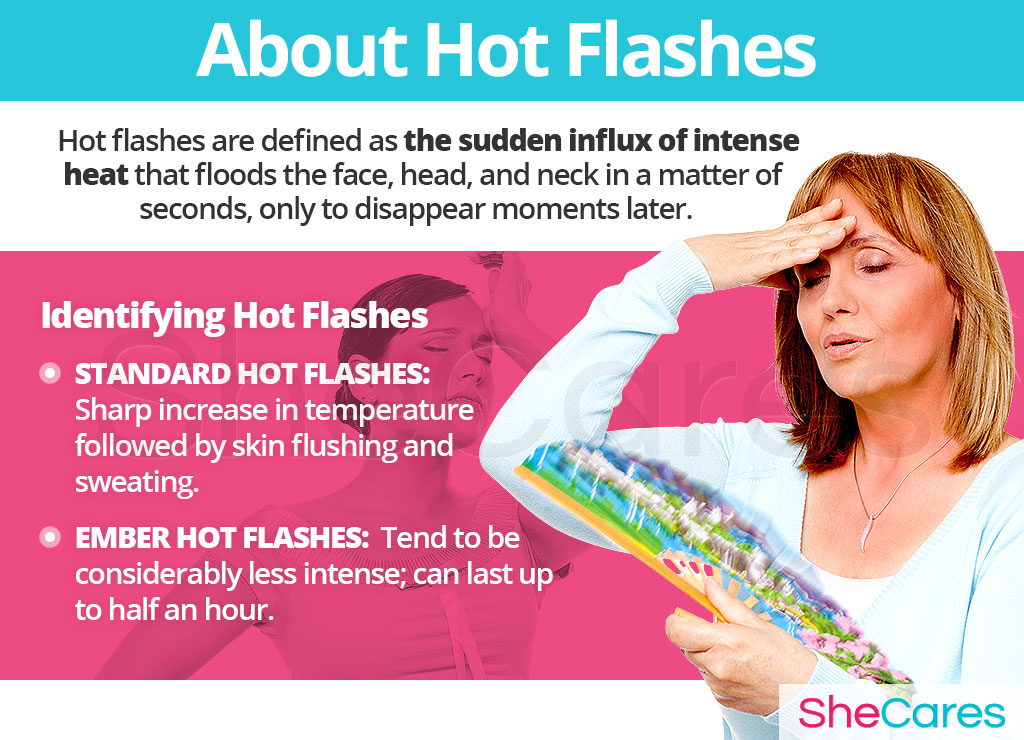
Causes
Learning about the causes of hot flashes provides the key to understanding how to prevent and treat these troublesome attacks. While the exact causes of hot flashes are complex and the mechanism behind them is not completely understood, most doctors and researchers agree that hormonal changes are the primary cause of hot flashes. In addition to these normal hormonal causes, other factors and medical conditions can, in more rare instances, cause hot flashes. Certain pre-existing conditions and lifestyle choices can also increase a woman's risk of suffering from them.
Continue reading to learn more about both the hormonal and other less common causes of hot flashes.
Hormonal Causes of Hot Flashes
Hormones are chemical messengers that control every organ in the body. When fluctuations occur, organs don't receive the correct signals to function adequately, so hormonal disorders occur. In this sense, it can be said that hot flashes are caused largely by the hormonal fluctuations during the transitions women go through during their reproductive life.
The exact way that hormones interact with certain parts of the body, particularly the brain, is not yet completely understood. However, there seems to be a clear link between the fluctuations between female sex hormones, estrogen and progesterone, and the regulation of a part of the brain known as the hypothalamus, which works as the body's “inner thermostat”.
Medical researchers have found that imbalances in the levels of estrogen and progesterone, and more particularly the sudden lack of estrogen, can confuse a woman's hypothalamus and make it believe that the body is overheating. As a result, this part of the brain quickly reacts by sending orders all over the body to cool down. This causes the blood vessels to dilate or expand, and large amounts of sweat are produced as a result.
This is why more women experience hot flashes during times of significant hormonal imbalance: puberty, PMS, menstruation, pregnancy, post-partum, and menopause. If estrogen and progesterone levels are not well regulated, women may experience hot flashes, as well as other psychological and physiological disturbances.
Furthermore, there are also specific hormonal causes according to the stage of a women's reproductive life in which this disorder appears. These specific hormonal causes, combined with other factors, can influence a woman's individual experience of hot flashes, as shown below:
Puberty is the stage in which a girl's body starts to secrete reproductive hormones and her body begins to develop. This hormone production, along with other factors like school pressures, can occasionally lead to hot flashes during puberty.
Pregnancy involves constant fluctuations in hormones, especially the reproductive hormones necessary for sustaining the baby. These changes, as well as other factors during gestation like weight gain, may contribute to the occurrence of hot flushes.
Post-partum and breastfeeding is another phase in which the levels of reproductive hormones shift, which can cause hot flashes, along with other factors such as stress.
Menopause is the period of transition in which reproductive hormones gradually decline to close out a woman's childbearing years. In addition to these hormonal changes, other factors may influence the experience of hot flashes, namely the speed of the transition.
Other Less Common Causes of Hot Flashes
While hormonal imbalance is the major underlying cause of hot flashes during a woman's life, experts also point out that disturbances in the way the body perceives heat may be caused by other less common underlying conditions.
Read on to find out more about the risk factors and triggers that can influence how women experience hot flashes.
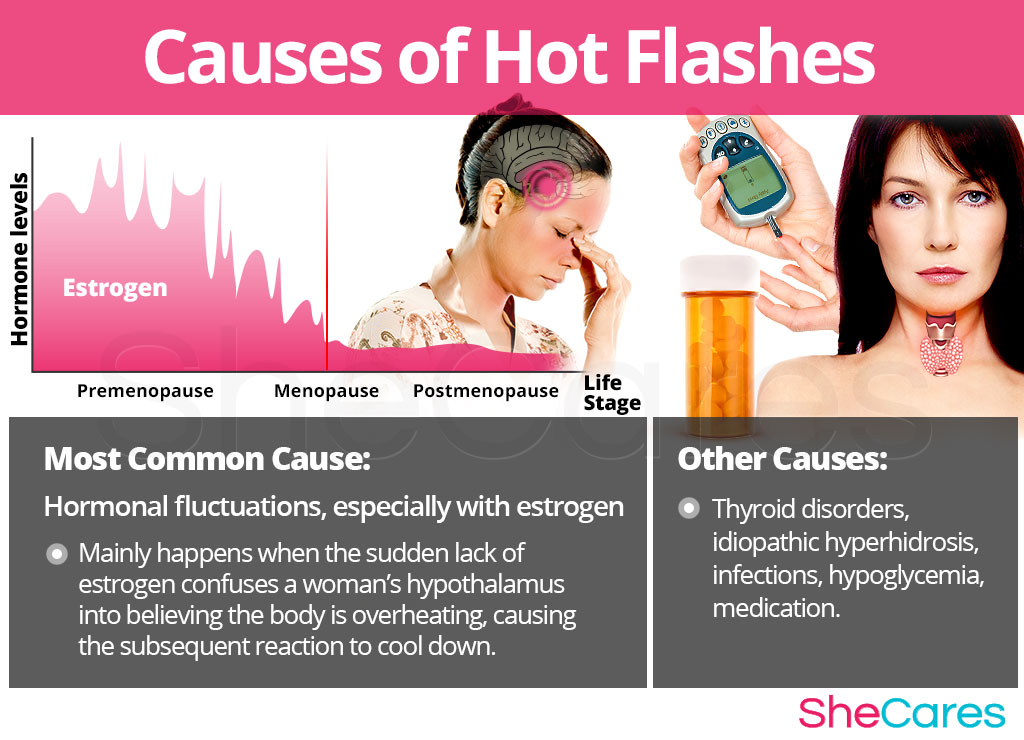
Risk Factors and Triggers
Risk Factors for Hot Flashes
Some women are more likely than others to suffer from hot flashes for inherent psychological, behavioral, and health reasons. These predisposing factors can affect a woman's hormone levels and increase the chances that a woman will develop hot flashes during her reproductive life.
Triggers of Hot Flashes
In addition to long-term risk factors, hot flashes can also be triggered by certain environmental phenomena and behavioral habits. Avoiding these environments or habits as much as possible may help to avoid the onset of hot flashes. These include warm environments and bingeing, among others.
Read below to find out more about the various signs and symptoms of hot flashes, which provide keys to identifying and treating the disorder.
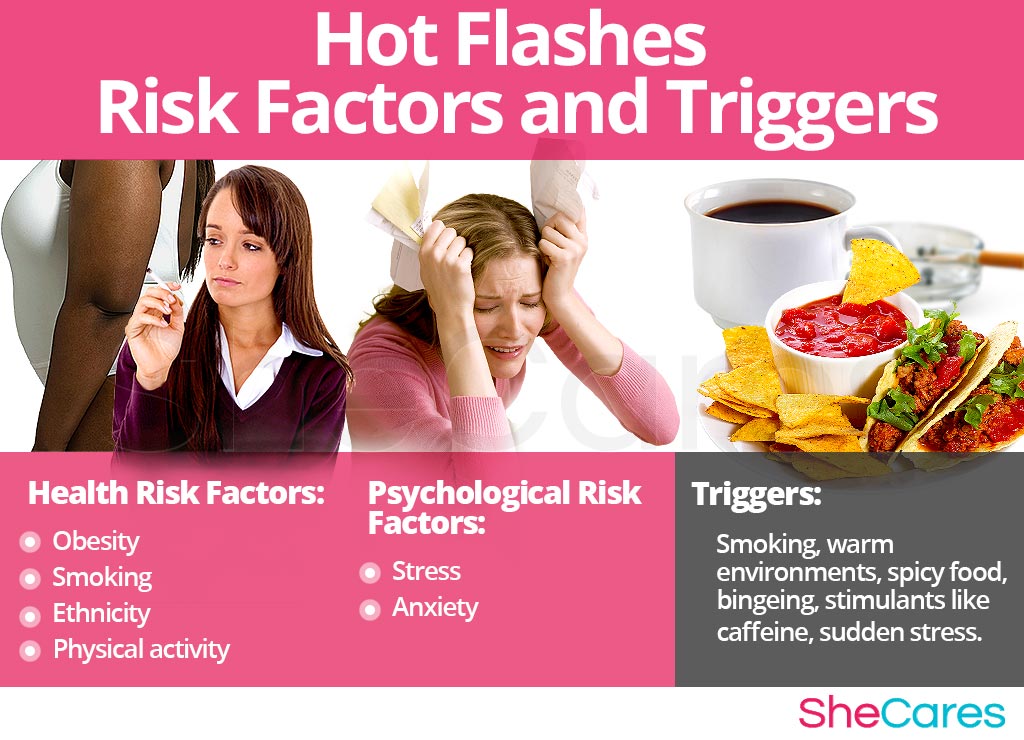
Signs and Symptoms
Because each woman has her own individual way of experiencing heat and weather changes, all women experience the symptoms of hot flashes differently and find they affect their lives in different ways. However, many symptoms of hot flashes are common for women going through a phase of hormonal imbalance.
Common Symptoms of Hot Flashes
- Rapid influx of heat, mostly in the upper body (especially face and neck, but may include the whole body)
- Flushing
- Abrupt sweating
- Rapid or accelerated pulse, palpitations
Some other symptoms often accompany hot flushes depending on the individual woman and the severity of the episode. The common symptoms may be followed by cold chills that signal the hot flash is over. Some women don't notice the previous symptoms and just feel the chills. At other times, they may be accompanied by nausea, headaches, and symptoms of anxiety.
Signs of Hot Flashes
What makes hot flashes so troublesome and disruptive is that they can flare up at any time, often without warning. Then, they pass so quickly that not even an accurate body temperature reading can be taken. Therefore, it is difficult for a doctor to measure signs of hot flashes directly. They will most likely use symptoms the patient reports and the criteria in the following section to diagnose hot flashes. Other signs of hormonal imbalance may also serve as medical signs:
- Rapid or irregular heartbeat
- Abnormal levels of reproductive hormones in the blood
- Fluctuating blood pressure or body temperature
- Abnormal bone density reading
Diagnosis of Hot Flashes
To diagnose and identify hot flashes, a doctor must typically perform three procedures. First, they should review the patient's medical history; then, they should conduct a physical exam, followed by some additional tests, if necessary.
Some women feel that their constant hot flashes are so severe that they interfere with daily life. Women may often seek treatment to help prevent and manage their hot flashes. Before attempting to treat hot flashes, it is advisable that women seek medical attention so that they can receive the proper diagnosis.
Complications of Hot Flashes
Fortunately, hot flashes have no medical complications. However, they can greatly disrupt daily activities and therefore have social ramifications. Women who suffer other symptoms of hormonal imbalance alongside hot flashes are more prone to anxiety and depression.
Women who experience severe and frequent hot flashes may wish to treat or even prevent them. Keep reading below to learn about how to prevent and manage hot flashes.
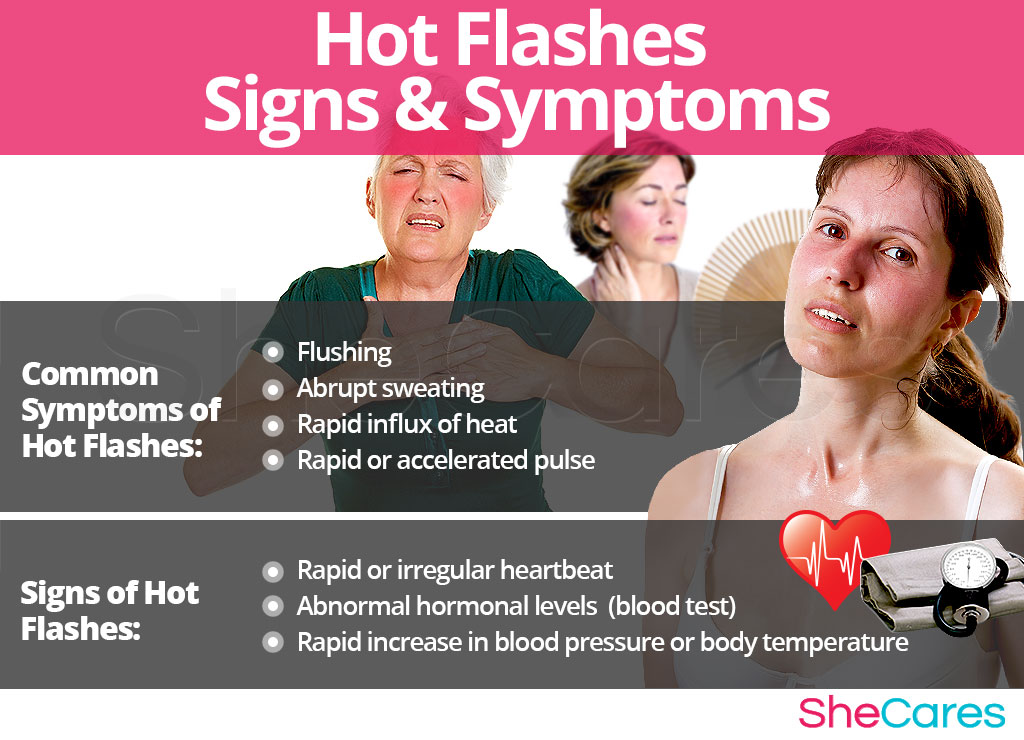
Prevention and Management
While there is no single way to completely prevent hot flashes, just as there is no way to stave off hormonal process, there are a few steps that a woman can take to lessen her chances of developing them, or to minimize the impact or the frequency of them if they do occur at some point.
In this sense, lifestyle changes for prevention are extremely important, especially with regard to diet, exercise, and healthy habits. Moreover, a woman may seek ways to complement these lifestyle approaches with the use of supplements that help her enhance her endocrine system and therefore help her prevent or ease hot flashes and symptoms of hormonal imbalance in general. Continue reading to learn more about lifestyle changes for preventing hot flashes.
For women who are already experiencing the symptoms, prevention may no longer be possible. Fortunately, there are many ways to manage hot flashes and night sweats in order to prevent the “flare-ups” or to make them as inconspicuous as possible when they inevitably happen. Keep reading to learn more about the different ways to manage hot flashes.
Managing Hot Flashes
Hot flashes can happen at any point of the day, but sometimes it would seem as if they had a knack for appearing at the most uncomfortable or inconvenient moments possible. However, making some minor daily changes, avoiding triggers, and taking the appropriate steps to control them at the first sign of an episode can make a huge difference for women who are trying to manage hot flashes and night sweats.
Alternative Management Tips for Hot Flashes
Alternative treatments are also a great way to manage hot flushes. These treatments may not tackle the hormonal cause behind most women's hot flashes, but they are effective in reducing stress in the short and medium term. Alternative treatments include acupuncture and biofeedback.
While these measures often help to reduce the frequency and intensity of hot flashes, they may be unable to treat the root of the problem, which is hormonal imbalance. However, there are several natural treatments that can treat the hormonal causes of hot flashes. Please continue to the next section to learn more about the approaches to treating hot flashes.
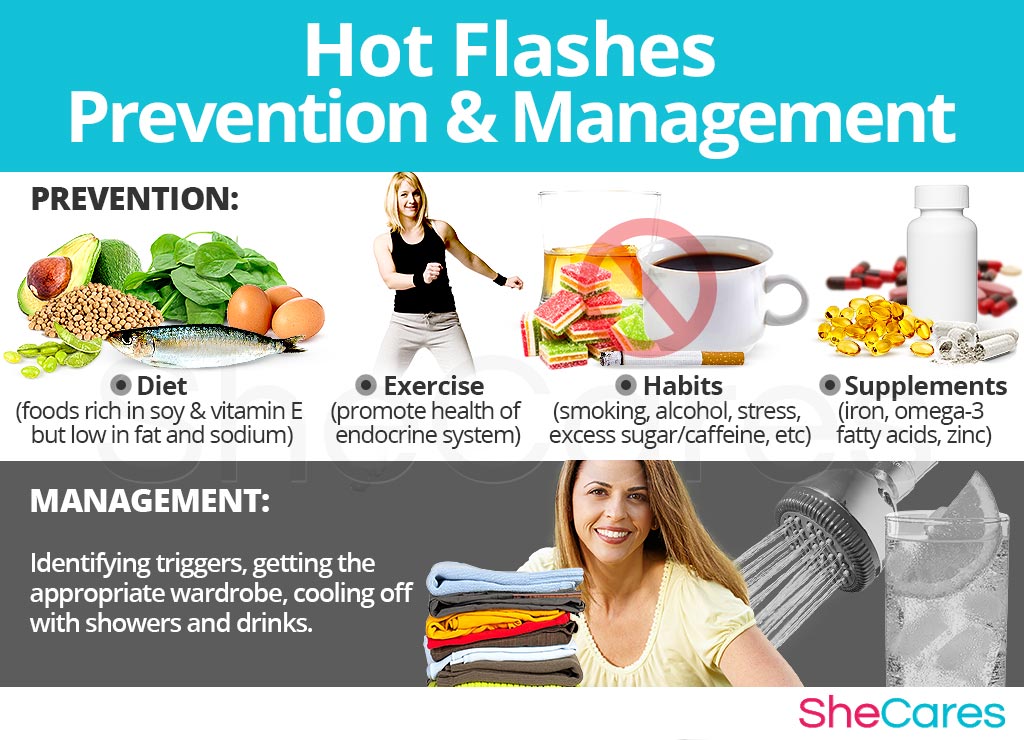
Treatments
Hot flashes are one of the most iconic symptoms of hormonal imbalance, not only because of their prevalence, but also because they can sometimes be very disruptive and frustrating. Luckily, it is more than possible to find an effective treatment for hot flashes.
Three Approaches to Treat Hot Flashes
Three levels of approaches can be considered for treating hot flashes. These are categorized as: (1) Lifestyle Changes, (2) Alternative Medicine, and (3) Pharmaceutical Options.
Women are encouraged to begin with the least risky approach to hot flashes treatment, lifestyle adjustments. While these are often effective in curbing the disorder, they alone do nothing to address the most common cause of hot flashes in women, hormonal imbalance. Fortunately, alternative medicine can be combined with lifestyle changes to provide a safe and effective treatment for hot flashes, night sweats, and other manifestations of hormonal imbalance.
Lifestyle Changes for Hot Flashes
This primary level of treatment involves the least amount of risk, though conversely it requires the highest amount of self-discipline. Many times some simple changes in lifestyle can reap huge benefits in fighting hot flashes and achieving a higher overall level of health. Fundamentally, and improved diet, regular exercise, and healthy habits can go a long way in combating hot flushes.
While these changes will help alleviate hot flashes, they do not address the problem directly at the hormonal source, so further treatment may be necessary. Alternative medicine has proven to be excellent for treating hot flashes in a safe and natural way.
Alternative Medicine for Hot Flashes
Alternative approaches involve little to no risk and can be an extremely effective way to treat hot flashes. This level can involve several different therapies. Supplements are the most prominent to help stabilize hormones or stimulate proper hypothalamic function. In the case of supplements that address hormone levels, there are two main types: phytoestrogenic and hormone-regulating herbal supplements.
Phytoestrogenic herbal supplements
These supplements, such as black cohosh, contain estrogenic components produced by plants that complement the low estrogen hormones in a woman's body, helping alleviate hot flashes. By introducing plant-based estrogens into the body, these herbs treat the underlying estrogen deficiency behind hot flashes.
They are mainly effective for menopausal women who are more likely to have low estrogen levels, but they are not necessarily effective for women in other stages of life, such as puberty.
Hormone-regulating herbal supplements
These supplements, including Macafem, stimulate the body's natural hormone production by nourishing the endocrine glands, helping the whole system produce hormones more efficiently. This ultimately results in balancing not only estrogen, but other important hormones as well.
These supplements can be considered a safe and effective way to treat the underlying hormonal imbalance behind hot flashes, and they can be taken throughout a woman's life, as they support the body's natural hormone production.
In addition, some vitamins and other herbal supplements may help relieve hot flashes, or at least make them more manageable.
A combination of approaches is usually the most effective route to take, Lifestyle changes combined with alternative medicine will most likely be the best way to alleviate the symptoms of hot flashes and night sweats. However, for some women the symptoms will be so severe that a more drastic treatment is necessary.
Pharmaceutical Options for Hot Flashes
While medical intervention is not necessary to treat hot flashes, some women may wish to consider pharmaceutical options if they are unable to find relief from natural treatments. For women considering this option, it is important to understand, and carefully weigh, the risks associated with this level of treatment, since interventions at the third level involve the highest risk and often the highest costs. Prescription medications to treat hot flashes include hormone-regulating and mood-regulating drugs.
If a woman's hot flashes are at the level of severity that she is still considering this final option, it is wise to speak to a healthcare professional for guidance.
These three levels of approaches are not mutually exclusive. A woman may use different approaches at different times or any combination of them, depending on the duration and severity of symptoms. Today more and more women find that dealing with symptoms of hormonal imbalance is best accomplished via a combination of healthy lifestyle and alternative treatments.
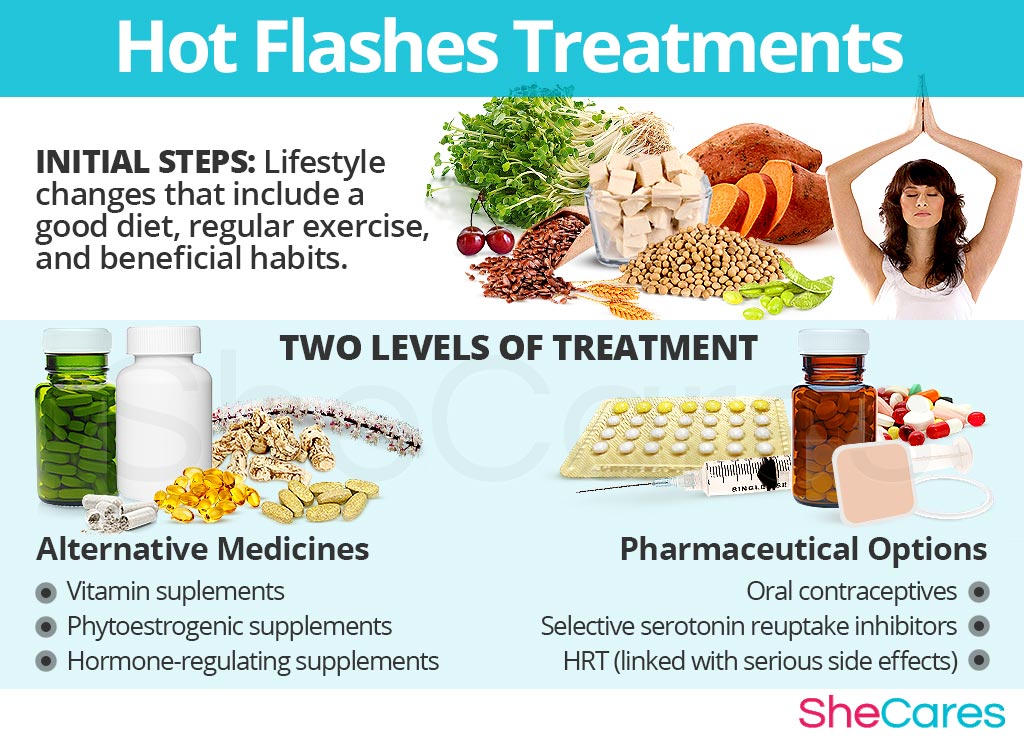
Sources
- MenopauseNow.(n.d.). Causes of hot flashes. Retrieved July 5th, 2013, from https://www.menopausenow.com/hot-flashes/causes
- MenopauseNow. (n.d.).Hot Flashes and Biofeedback. Retrieved July 5th, 2013, from https://www.menopausenow.com/hot-flashes/articles/hot-flashes-and-biofeedback
- MenopauseNow. (n.d.). Hot Flashes Treatments. Retrieved July 5th, 2013, from https://www.menopausenow.com/hot-flashes/treatments
- Black, A. (2006). Good news for menopausal women: You can avoid hot flashes by changing your diet. Retrieved July 5th, 2013, from http://www.naturalnews.com/019538_hot_flashes_womens_health.html
- Breast Cancer ORG.(2013). Menopause Symptoms: Hot Flashes. Retrieved July 5th, 2013, from http://www.breastcancer.org/tips/menopausal/facing/hot_flashes
- Countdown My Pregnancy. (n.d.). Sweating/Hot Flashes - Pregnancy Symptoms & Discomforts. Retrieved July 5th, 2013, from http://www.countdownmypregnancy.com/pregnancy/symptom.php?sid=59
- Mayo Clinic Staff. (2011). Hot Flashes. Retrieved July 5th, 2013, from http://www.mayoclinic.com/health/hot-flashes/DS01143
- Mayo Clinic. (2011). Hot Flashes: Risk Factors. Retrieved July 5th, 2013, from http://www.mayoclinic.com/health/hot-flashes/DS01143/DSECTION=risk-factors
- National Health Service UK. (2012). Menopause Symptoms. Retrieved July 5th, 2013 from http://www.nhs.uk/Conditions/Menopause/Pages/Symptoms.aspx
- Stanford Health Care. (n.d.). Common postpartum discomforts. Retrieved July 5th, 2013, from http://lowmg.com/info/ob/ob_book/common_postpartum_discomforts.pdf


